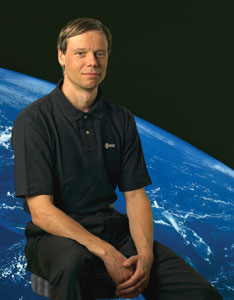European Space Agency astronaut Christer Fuglesang explains how his training in particle physics at CERN prepared him for a career in space.

In June 1990, while I was a Fellow at CERN in experimental particle physics, a friend told me that the European Space Agency (ESA) was recruiting new astronauts. Although I loved (and still love!) the physics research work I was doing, and being at CERN in particular, I had always dreamed of going into space one day. It did not take me long to decide that at the very least I should inquire further, though I was concerned that my background was quite unlike the kind of research that is typically performed during manned space flights. I discussed this with the Swedish Space Board before asking them to send me the application papers (a densely written 16 page form), but they confirmed that I was the kind of person that could be of interest to ESA.
The selection process for just six new ESA astronauts took almost two years. Initially, each ESA member state selected up to five candidates, and then ESA chose from the 60 pilots, engineers, medical doctors, physicists and other scientists whose names were put forward. The selection process involved extensive medical screening, as well as several interviews. My CERN background was invaluable – though it is not space science per se, particle physics is closely related to astrophysics and cosmology, and also to radiation, which is a problem for humans and technology in space. My hands-on experience with experimental hardware was useful, but even more important, I believe, was my experience of working in a highly international environment, and the language skills I had gained there.
During one interview, a member of the selection panel remarked that although I had a fairly long publication list, he had noticed that the publications had up to 100 names on them. How could he be sure of my contribution? I had to explain how particle physics experiments are generally performed by large collaborations from many countries. This is increasingly true today, with as many as a thousand collaborators being involved in a single experiment. Fortunately, I was able to point out one or two papers that I had produced myself.
It should be noted that astronauts rarely perform their own experiments in space, and therefore a broad background is important. The exception is when so-called “payload specialists” fly on dedicated science missions, having been selected because of their expertise in a particular scientific field. A mission crew has to deal with technically advanced equipment on a daily basis, and must be able to operate various experiments as well as spacecraft systems. Having worked with particle physics experiments that demand high technology in many fields, I had already been exposed to several areas that one encounters in space activities.
Astronauts are among the prime communicators for the space programme – one could say they are “space ambassadors”. My scientific background has been extremely useful to me during many talks and presentations – in particular during the question-and-answer sessions that often ensue.
The International Space Station (ISS) is certainly “big science”, very much as CERN is. I recognize many similarities, although the ISS is more politicized. There are often complaints that ISS science is too expensive, and that the money could be better spent elsewhere. This is a misunderstanding of the real goals of the ISS, which are to learn how to build and live in space, and to prepare for future space developments. In some ways, it is like the basic science carried out at CERN – we do it out of curiosity, and we do not know what the eventual outcome will be. However, we are convinced that one day we will achieve results that will be of great benefit for all humankind. In the meantime, we take this great opportunity to carry out experiments in a unique environment, and to learn as much as possible about it, in particular how humans react to long periods in space.
I have always tried to combine my interest in particle physics with being an astronaut. I was dreaming of having my own experiment to work on in space, when I heard about the light flashes in the eyes that most astronauts experience in space. It was clear that these are from particles that penetrate the eyes, but until then no-one had put an active detector in space, in front of the eyes, in an effort to correlate particles and light flashes. This eventually led to the Italian-Russian-Swedish SilEye project, based on silicon strip detectors. The collaboration flew two detectors to the Russian space station Mir, and now also has one on the ISS. I hope to get a chance to use it in the summer of 2003, when I am finally scheduled to fly on the space shuttle and spend a week on the ISS.





